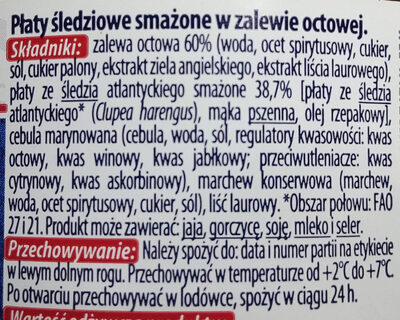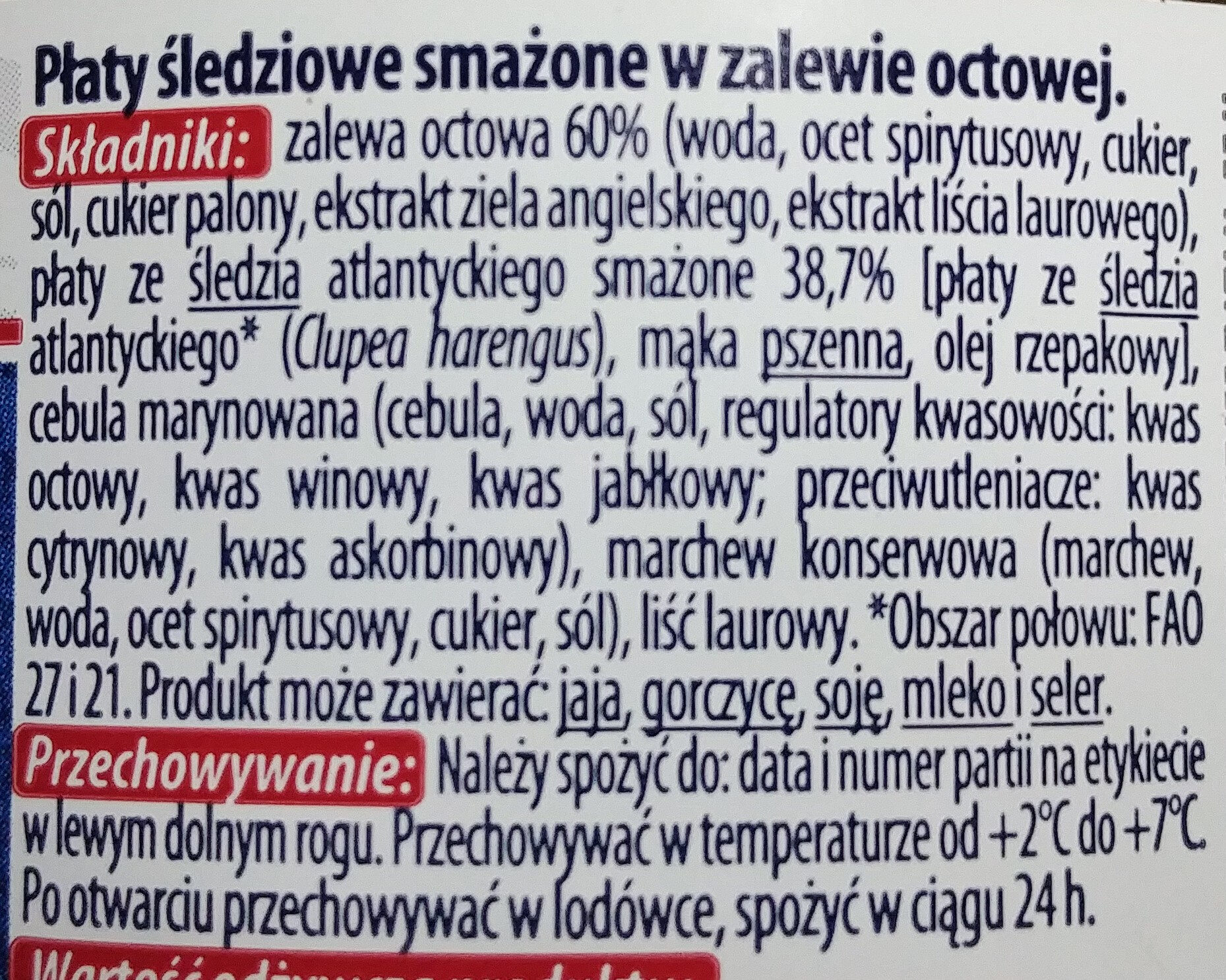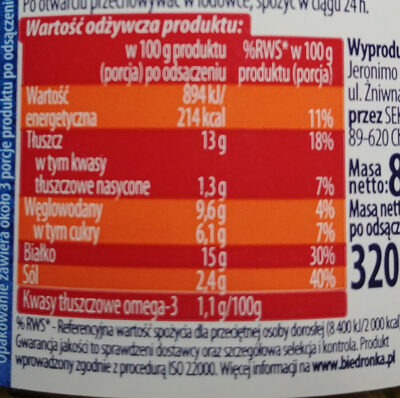Help us make food transparency the norm!
As a non-profit organization, we depend on your donations to continue informing consumers around the world about what they eat.
The food revolution starts with you!
Płaty śledziowe smażone w zalewie octowej - Marinero - 320 g (przed odsączeniem 800 g)
Płaty śledziowe smażone w zalewie octowej - Marinero - 320 g (przed odsączeniem 800 g)
This product page is not complete. You can help to complete it by editing it and adding more data from the photos we have, or by taking more photos using the app for Android or iPhone/iPad. Thank you!
×
Barcode: 5902353020962 (EAN / EAN-13)
Quantity: 320 g (przed odsączeniem 800 g)
Packaging: Glass, Clear Glass, Lid
Brands: Marinero
Categories: Seafood, Fishes and their products, Canned foods, Fishes, Fatty fishes, Canned fishes, Herring, Canned herrings, Fried Atlantic herring
Origin of ingredients: Atlantic Ocean, North-East Atlantic Ocean, Northwest Atlantic Ocean
Manufacturing or processing places: Seko, PL 89-620, Chojnice
Traceability code: PL 22021804 WE
Stores: Biedronka
Countries where sold: Poland
Matching with your preferences
Health
Ingredients
-
31 ingredients
: Zalewa octowa 60% (woda, ocet spirytusowy, cukier, sól, cukier palony, ekstrakt ziela angielskiego, ekstrakt liścia laurowego), płaty ze śledzia atlantyckiego smażone 38,7% [płaty ze śledzia atlantyckiego* (Clupea harengus), mąka pszenna, olej rzepakowy], cebula marynowana (cebula, woda, sól, regulatory kwasowości (kwas octowy, kwas winowy, kwas jabłkowy); przeciwutleniacze (kwas cytrynowy, kwas askorbinowy)), marchew konserwowa (marchew, woda, ocet spirytusowy, cukier, sól), liść laurowy.Allergens: Fish, Gluten, pl:śledzia, pl:śledziaTraces: Celery, Eggs, Milk, Mustard, Soybeans
Food processing
-
Processed foods
Elements that indicate the product is in the 3 - Processed foods group:
- Ingredient: Salt
- Ingredient: Sugar
Food products are classified into 4 groups according to their degree of processing:
- Unprocessed or minimally processed foods
- Processed culinary ingredients
- Processed foods
- Ultra processed foods
The determination of the group is based on the category of the product and on the ingredients it contains.
Additives
-
E260 - Acetic acid
Acetic acid: Acetic acid , systematically named ethanoic acid , is a colorless liquid organic compound with the chemical formula CH3COOH -also written as CH3CO2H or C2H4O2-. When undiluted, it is sometimes called glacial acetic acid. Vinegar is no less than 4% acetic acid by volume, making acetic acid the main component of vinegar apart from water. Acetic acid has a distinctive sour taste and pungent smell. In addition to household vinegar, it is mainly produced as a precursor to polyvinyl acetate and cellulose acetate. It is classified as a weak acid since it only partially dissociates in solution, but concentrated acetic acid is corrosive and can attack the skin. Acetic acid is the second simplest carboxylic acid -after formic acid-. It consists of a methyl group attached to a carboxyl group. It is an important chemical reagent and industrial chemical, used primarily in the production of cellulose acetate for photographic film, polyvinyl acetate for wood glue, and synthetic fibres and fabrics. In households, diluted acetic acid is often used in descaling agents. In the food industry, acetic acid is controlled by the food additive code E260 as an acidity regulator and as a condiment. In biochemistry, the acetyl group, derived from acetic acid, is fundamental to all forms of life. When bound to coenzyme A, it is central to the metabolism of carbohydrates and fats. The global demand for acetic acid is about 6.5 million metric tons per year -Mt/a-, of which approximately 1.5 Mt/a is met by recycling; the remainder is manufactured from methanol. Vinegar is mostly dilute acetic acid, often produced by fermentation and subsequent oxidation of ethanol.Source: Wikipedia
-
E296 - Malic acid
Malic acid: Malic acid is an organic compound with the molecular formula C4H6O5. It is a dicarboxylic acid that is made by all living organisms, contributes to the pleasantly sour taste of fruits, and is used as a food additive. Malic acid has two stereoisomeric forms -L- and D-enantiomers-, though only the L-isomer exists naturally. The salts and esters of malic acid are known as malates. The malate anion is an intermediate in the citric acid cycle.Source: Wikipedia
-
E330 - Citric acid
Citric acid is a natural organic acid found in citrus fruits such as lemons, oranges, and limes.
It is widely used in the food industry as a flavor enhancer, acidulant, and preservative due to its tart and refreshing taste.
Citric acid is safe for consumption when used in moderation and is considered a generally recognized as safe (GRAS) food additive by regulatory agencies worldwide.
-
E334 - L(+)-tartaric acid
Tartaric acid: Tartaric acid is a white, crystalline organic acid that occurs naturally in many fruits, most notably in grapes, but also in bananas, tamarinds, and citrus. Its salt, potassium bitartrate, commonly known as cream of tartar, develops naturally in the process of winemaking. It is commonly mixed with sodium bicarbonate and is sold as baking powder used as a leavening agent in food preparation. The acid itself is added to foods as an antioxidant and to impart its distinctive sour taste. Tartaric is an alpha-hydroxy-carboxylic acid, is diprotic and aldaric in acid characteristics, and is a dihydroxyl derivative of succinic acid.Source: Wikipedia
Ingredients analysis
-
Palm oil content unknown
Unrecognized ingredients: pl:zalewa-octowa, pl:cukier-palony, pl:ekstrakt-liścia-laurowego, pl:płaty-ze-śledzia-atlantyckiego-smażone, pl:płaty-ze-śledzia-atlantyckiegoSome ingredients could not be recognized.
We need your help!
You can help us recognize more ingredients and better analyze the list of ingredients for this product and others:
- Edit this product page to correct spelling mistakes in the ingredients list, and/or to remove ingredients in other languages and sentences that are not related to the ingredients.
- Add new entries, synonyms or translations to our multilingual lists of ingredients, ingredient processing methods, and labels.
If you would like to help, join the #ingredients channel on our Slack discussion space and/or learn about ingredients analysis on our wiki. Thank you!
-
Non-vegan
Non-vegan ingredients: Atlantic herringSome ingredients could not be recognized.
We need your help!
You can help us recognize more ingredients and better analyze the list of ingredients for this product and others:
- Edit this product page to correct spelling mistakes in the ingredients list, and/or to remove ingredients in other languages and sentences that are not related to the ingredients.
- Add new entries, synonyms or translations to our multilingual lists of ingredients, ingredient processing methods, and labels.
If you would like to help, join the #ingredients channel on our Slack discussion space and/or learn about ingredients analysis on our wiki. Thank you!
-
Non-vegetarian
Non-vegetarian ingredients: Atlantic herringSome ingredients could not be recognized.
We need your help!
You can help us recognize more ingredients and better analyze the list of ingredients for this product and others:
- Edit this product page to correct spelling mistakes in the ingredients list, and/or to remove ingredients in other languages and sentences that are not related to the ingredients.
- Add new entries, synonyms or translations to our multilingual lists of ingredients, ingredient processing methods, and labels.
If you would like to help, join the #ingredients channel on our Slack discussion space and/or learn about ingredients analysis on our wiki. Thank you!
-
Details of the analysis of the ingredients
We need your help!
Some ingredients could not be recognized.
We need your help!
You can help us recognize more ingredients and better analyze the list of ingredients for this product and others:
- Edit this product page to correct spelling mistakes in the ingredients list, and/or to remove ingredients in other languages and sentences that are not related to the ingredients.
- Add new entries, synonyms or translations to our multilingual lists of ingredients, ingredient processing methods, and labels.
If you would like to help, join the #ingredients channel on our Slack discussion space and/or learn about ingredients analysis on our wiki. Thank you!
: Zalewa octowa 60% (woda, ocet spirytusowy, cukier, sól, cukier palony, ziela angielskiego, ekstrakt liścia laurowego), płaty ze _śledzia_ atlantyckiego smażone 38.7% (płaty ze _śledzia_ atlantyckiego (Clupea harengus), mąka _pszenna_, olej rzepakowy), cebula (cebula, woda, sól, regulatory kwasowości (kwas octowy, kwas winowy, kwas jabłkowy), przeciwutleniacze (kwas cytrynowy, kwas askorbinowy)), marchew (marchew, woda, ocet spirytusowy, cukier, sól), liść laurowy- Zalewa octowa -> pl:zalewa-octowa - percent_min: 60 - percent: 60 - percent_max: 60
- woda -> en:water - vegan: yes - vegetarian: yes - ciqual_food_code: 18066 - percent_min: 14.3 - percent_max: 60
- ocet spirytusowy -> en:spirit-vinegar - vegan: yes - vegetarian: yes - ciqual_food_code: 11018 - percent_min: 0 - percent_max: 30
- cukier -> en:sugar - vegan: yes - vegetarian: yes - ciqual_proxy_food_code: 31016 - percent_min: 0 - percent_max: 6.1
- sól -> en:salt - vegan: yes - vegetarian: yes - ciqual_food_code: 11058 - percent_min: 0 - percent_max: 2.4
- cukier palony -> pl:cukier-palony - percent_min: 0 - percent_max: 2.4
- ziela angielskiego -> en:allspice - vegan: yes - vegetarian: yes - ciqual_food_code: 20151 - percent_min: 0 - percent_max: 2.4
- ekstrakt liścia laurowego -> pl:ekstrakt-liścia-laurowego - percent_min: 0 - percent_max: 2.4
- płaty ze _śledzia_ atlantyckiego smażone -> pl:płaty-ze-śledzia-atlantyckiego-smażone - percent_min: 38.7 - percent: 38.7 - percent_max: 38.7
- płaty ze _śledzia_ atlantyckiego -> pl:płaty-ze-śledzia-atlantyckiego - percent_min: 12.9 - percent_max: 38.7
- Clupea harengus -> en:atlantic-herring - vegan: no - vegetarian: no - ciqual_food_code: 26011 - percent_min: 12.9 - percent_max: 38.7
- mąka _pszenna_ -> en:wheat-flour - vegan: yes - vegetarian: yes - ciqual_proxy_food_code: 9410 - percent_min: 0 - percent_max: 19.35
- olej rzepakowy -> en:rapeseed-oil - vegan: yes - vegetarian: yes - from_palm_oil: no - percent_min: 0 - percent_max: 12.9
- płaty ze _śledzia_ atlantyckiego -> pl:płaty-ze-śledzia-atlantyckiego - percent_min: 12.9 - percent_max: 38.7
- cebula -> en:onion - vegan: yes - vegetarian: yes - ciqual_food_code: 20034 - percent_min: 0.433333333333332 - percent_max: 1.3
- cebula -> en:onion - vegan: yes - vegetarian: yes - ciqual_food_code: 20034 - percent_min: 0 - percent_max: 1.3
- woda -> en:water - vegan: yes - vegetarian: yes - ciqual_food_code: 18066 - percent_min: 0 - percent_max: 0.649999999999999
- sól -> en:salt - vegan: yes - vegetarian: yes - ciqual_food_code: 11058 - percent_min: 0 - percent_max: 0.433333333333332
- regulatory kwasowości -> en:acidity-regulator - percent_min: 0 - percent_max: 0.324999999999999
- kwas octowy -> en:e260 - vegan: yes - vegetarian: yes - percent_min: 0 - percent_max: 0.324999999999999
- kwas winowy -> en:e334 - vegan: yes - vegetarian: yes - percent_min: 0 - percent_max: 0.1625
- kwas jabłkowy -> en:e296 - vegan: yes - vegetarian: yes - percent_min: 0 - percent_max: 0.108333333333333
- przeciwutleniacze -> en:antioxidant - percent_min: 0 - percent_max: 0.259999999999999
- kwas cytrynowy -> en:e330 - vegan: yes - vegetarian: yes - percent_min: 0 - percent_max: 0.259999999999999
- kwas askorbinowy -> en:e300 - vegan: yes - vegetarian: yes - percent_min: 0 - percent_max: 0.13
- marchew -> en:carrot - vegan: yes - vegetarian: yes - ciqual_food_code: 20009 - percent_min: 0 - percent_max: 0.649999999999996
- marchew -> en:carrot - vegan: yes - vegetarian: yes - ciqual_food_code: 20009 - percent_min: 0 - percent_max: 0.649999999999996
- woda -> en:water - vegan: yes - vegetarian: yes - ciqual_food_code: 18066 - percent_min: 0 - percent_max: 0.324999999999998
- ocet spirytusowy -> en:spirit-vinegar - vegan: yes - vegetarian: yes - ciqual_food_code: 11018 - percent_min: 0 - percent_max: 0.216666666666665
- cukier -> en:sugar - vegan: yes - vegetarian: yes - ciqual_proxy_food_code: 31016 - percent_min: 0 - percent_max: 0.162499999999999
- sól -> en:salt - vegan: yes - vegetarian: yes - ciqual_food_code: 11058 - percent_min: 0 - percent_max: 0.162499999999999
- liść laurowy -> en:bay-leaf - vegan: yes - vegetarian: yes - ciqual_food_code: 11053 - percent_min: 0 - percent_max: 0.433333333333331
Nutrition
-
Poor nutritional quality
⚠ ️Warning: the amount of fiber is not specified, their possible positive contribution to the grade could not be taken into account.⚠ ️Warning: the amount of fruits, vegetables and nuts is not specified on the label, it was estimated from the list of ingredients: 8This product is not considered a beverage for the calculation of the Nutri-Score.
Positive points: 0
- Proteins: 5 / 5 (value: 15, rounded value: 15)
- Fiber: 0 / 5 (value: 0, rounded value: 0)
- Fruits, vegetables, nuts, and colza/walnut/olive oils: 0 / 5 (value: 8.73333333333334, rounded value: 8.7)
Negative points: 14
- Energy: 2 / 10 (value: 894, rounded value: 894)
- Sugars: 1 / 10 (value: 6.1, rounded value: 6.1)
- Saturated fat: 1 / 10 (value: 1.3, rounded value: 1.3)
- Sodium: 10 / 10 (value: 960, rounded value: 960)
The points for proteins are not counted because the negative points are greater or equal to 11.
Nutritional score: (14 - 0)
Nutri-Score:
-
Nutrient levels
-
Fat in moderate quantity (13%)
What you need to know- A high consumption of fat, especially saturated fats, can raise cholesterol, which increases the risk of heart diseases.
Recommendation: Limit the consumption of fat and saturated fat- Choose products with lower fat and saturated fat content.
-
Saturated fat in low quantity (1.3%)
What you need to know- A high consumption of fat, especially saturated fats, can raise cholesterol, which increases the risk of heart diseases.
Recommendation: Limit the consumption of fat and saturated fat- Choose products with lower fat and saturated fat content.
-
Sugars in moderate quantity (6.1%)
What you need to know- A high consumption of sugar can cause weight gain and tooth decay. It also augments the risk of type 2 diabetes and cardio-vascular diseases.
Recommendation: Limit the consumption of sugar and sugary drinks- Sugary drinks (such as sodas, fruit beverages, and fruit juices and nectars) should be limited as much as possible (no more than 1 glass a day).
- Choose products with lower sugar content and reduce the consumption of products with added sugars.
-
Salt in high quantity (2.4%)
What you need to know- A high consumption of salt (or sodium) can cause raised blood pressure, which can increase the risk of heart disease and stroke.
- Many people who have high blood pressure do not know it, as there are often no symptoms.
- Most people consume too much salt (on average 9 to 12 grams per day), around twice the recommended maximum level of intake.
Recommendation: Limit the consumption of salt and salted food- Reduce the quantity of salt used when cooking, and don't salt again at the table.
- Limit the consumption of salty snacks and choose products with lower salt content.
-
-
Nutrition facts
Nutrition facts As sold
for 100 g / 100 mlAs sold
per serving (107g)Compared to: Canned herrings Energy 894 kj
(214 kcal)957 kj
(229 kcal)+4% Fat 13 g 13.9 g -14% Saturated fat 1.3 g 1.39 g -54% Omega 3 fat 1,100 mg 1,180 mg -15% Carbohydrates 9.6 g 10.3 g +125% Sugars 6.1 g 6.53 g +87% Fiber ? ? Proteins 15 g 16.1 g +22% Salt 2.4 g 2.57 g +76% Fruits‚ vegetables‚ nuts and rapeseed‚ walnut and olive oils (estimate from ingredients list analysis) 8.733 % 8.733 %
Environment
-
Eco-Score B - Low environmental impact
⚠ ️Select a country in order to include the full impact of transportation.The Eco-Score is an experimental score that summarizes the environmental impacts of food products.→ The Eco-Score was initially developped for France and it is being extended to other European countries. The Eco-Score formula is subject to change as it is regularly improved to make it more precise and better suited to each country.Life cycle analysis
-
Average impact of products of the same category: B (Score: 66/100)
Category: Atlantic herring, fried
Category: Atlantic herring, fried
- PEF environmental score: 0.38 (the lower the score, the lower the impact)
- including impact on climate change: 2.80 kg CO2 eq/kg of product
Stage Impact Agriculture
63.5 %Processing
0.0 %Packaging
5.0 %Transportation
25.0 %Distribution
2.9 %Consumption
3.5 %
Bonuses and maluses
-
Missing origins of ingredients information
Malus: -5
⚠ ️ The origins of the ingredients of this product are not indicated.
If they are indicated on the packaging, you can modify the product sheet and add them.
If you are the manufacturer of this product, you can send us the information with our free platform for producers.
-
Packaging with a low impact
Malus: 0
Shape Material Recycling Impact Lid Clear Glass Low
Eco-Score for this product
-
Impact for this product: B (Score: 61/100)
Product: Płaty śledziowe smażone w zalewie octowej - Marinero - 320 g (przed odsączeniem 800 g)
Life cycle analysis score: 66
Sum of bonuses and maluses: -5
Final score: 61/100
-
Carbon footprint
-
Equal to driving 1.5 km in a petrol car
280 g CO² per 100g of product
The carbon emission figure comes from ADEME's Agribalyse database, for the category: Atlantic herring, fried (Source: ADEME Agribalyse Database)
Stage Impact Agriculture
47.7 %Processing
0.0 %Packaging
8.0 %Transportation
39.5 %Distribution
1.6 %Consumption
3.1 %
Packaging
-
Packaging with a low impact
-
Packaging parts
Lid (Clear Glass)
-
Packaging materials
Material % Packaging weight Packaging weight per 100 g of product Glass
-
Transportation
-
Origins of ingredients
Missing origins of ingredients information
⚠ ️ The origins of the ingredients of this product are not indicated.
If they are indicated on the packaging, you can modify the product sheet and add them.
If you are the manufacturer of this product, you can send us the information with our free platform for producers.Add the origins of ingredients for this product Add the origins of ingredients for this product
Report a problem
-
Incomplete or incorrect information?
Category, labels, ingredients, allergens, nutritional information, photos etc.
If the information does not match the information on the packaging, please complete or correct it. Open Food Facts is a collaborative database, and every contribution is useful for all.
Data sources
Product added on by pyrka
Last edit of product page on by arc2.
Product page also edited by openfoodfacts-contributors, sierigh, wojciech-dopieralski-op-pl.











